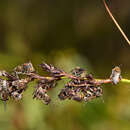Brief Summary
provided by Catalog of Hymenoptera in America North of Mexico
Members of this subfamily are especially numerous in the Old World tropics including those of the Australian Region. They are relatively poorly represented in the Holarctic Region. Only the widespread genus Nomia is present in the Nearctic Region and apparently all of the species are polyleges, obtaining their pollen and nectar from the flowers of a wide variety of both native and introduced plants. However, some of the species (e.g., Nomia nevadensis Cresson and N. triangulifera Vachal) appear to collect pollen only from the flowers of the Compositae. At least one of the species, the alkali bee (N. melanderi Cockerell), is an exceptionally valuable pollinator of alfalfa (Medicago sativa) and has been managed successfully in artificial nesting sites so as to enhance the pollination of this important agricultural crop. ~According to Cockerell (1910. U. S. Natl. Mus., Proc. 38: 292), Nomia is doubtless of Old World origin, probably reaching America in later Miocene times. Earlier, Cockerell (1908. Canad. Ent. 40: 144) remarked that the genus may have reached the Western Hemisphere about the same time and doubtless by the same route as the Elephantidae. Later, Cockerell (1935. In Blair, N.Y. Ent. Soc., Jour. 43: 201) commented that the Nomia fauna of the New World includes at least three different groups, the ancestors of which must have come over from Asia at different times. He believed that the oldest of these is Dieunomia and that the invasion of North America by Nomia from Asia is analogous to that of the pipits (genus Anthus) among the birds. ~The subfamily Nomiinae is not known to occur south of Mexico and Cuba. Years ago, Cockerell (1918. Ann. and Mag. Nat. Hist. (9) 1: 161) described Nomia expulsa as a new species from French Guiana (Guyane, Maroni) and wondered it it might be incorrectly labeled. Subsequently, Cockerell (1930. Amer. Mus. Novitates 433: 11) stated that he suspected the label data are erroneous, and that the specimens really came from somewhere in tropical Asia. Since N. expulsa has two long spines on the metanotum, Cockerell (ibid.) assigned the species to the subgenus Hoplonomia Ashmead.
- bibliographic citation
- Catalog of Hymenoptera in America North of Mexico. 1979. Prepared cooperatively by specialists on the various groups of Hymenoptera under the direction of Karl V. Krombein and Paul D. Hurd, Jr., Smithsonian Institution, and David R. Smith and B. D. Burks, Systematic Entomology Laboratory, Insect Identification and Beneficial Insect Introduction Institute. Science and Education Administration, United States Department of Agriculture.
Nomiinae: Brief Summary
provided by wikipedia EN
Nomiinae is a subfamily of sweat bees in the family Halictidae. There are about 11 genera and at least 550 described species in Nomiinae.
 Nomia universitatis
Nomia universitatis
- license
- cc-by-sa-3.0
- copyright
- Wikipedia authors and editors


 Nomia universitatis
Nomia universitatis